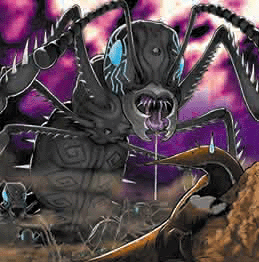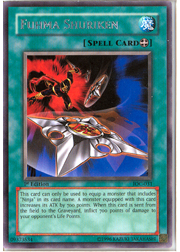“You’ll find ants. Sometimes, you’ll find anteaters. Occasionally, you find anteaters eating ants. But every now and then, you find ants that eat anteaters. Those are the ones you don’t mess with.”
Now that the Shadow of Infinity Sneak Preview event has drawn to a close, the Insect overlords can take over. With improved abilities, an above-average fighter, and an adorable (for a bug) searcher, the Insects are truly ready to be played. This week, we’ll cover the mechanics of a few new members of the brood so everyone can get started with their new Insect decks.
Parasitic Ticky
Parasitic Ticky has a simple effect, but it makes an important distinction that needs to be remembered. “The ATK and DEF of this card are equal to the number of Tokens on the field x 500 points.”
In general, this effect will typically refer to monster tokens. Spell and trap cards normally stick to the use of “counters” and will thus not be of any use to Parasitic Ticky. Remember that monster tokens of any variety are good for your Parasitic Ticky, while spell counters are not.
What happens if you’re up against Relinquished and it uses its effect to absorb one of your monster tokens? Now that the monster token is being treated as an equip spell card, will it still increase your Parasitic Ticky’s ATK value? It most certainly will. Even though it’s being treated as an equip spell card, it’s still a token. This part of its nature doesn’t change.
The Anteater-Eating-Ant
 The text of Anteatereatingant says, “This card cannot be Normal Summoned or Set. This card cannot be Special Summoned except by sending 2 Spell or Trap Cards on your side of the field to the Graveyard. This card can destroy 1 Spell or Trap Card on your opponent's side of the field, but it cannot attack this turn if you activate this effect.”
The text of Anteatereatingant says, “This card cannot be Normal Summoned or Set. This card cannot be Special Summoned except by sending 2 Spell or Trap Cards on your side of the field to the Graveyard. This card can destroy 1 Spell or Trap Card on your opponent's side of the field, but it cannot attack this turn if you activate this effect.”
You need to keep in mind that you can only special summon Anteatereatingant from your hand during your main phase, similar to monsters like Cyber Dragon and The Fiend Megacyber. You will find that special summoning Anteatereatingant is actually rather easy to accomplish, since you only need two spell or trap cards to satisfy it. With the right choices, you can even make this cost result in a combo.
For example, Black Pendant inflicts 500 points of damage to your opponent’s life points when it’s sent from the field to your graveyard. With two of these, you could special summon your Anteatereatingant and inflict 1000 points of damage at the same time.
 You can take it another step forward by using Fuhma Shuriken. Two of these would allow you to inflict 1400 points of damage. It may seem strange to include a card that only equips to monsters with “Ninja” in their card name, and if you’re using Insect-type monsters, you’re probably thinking that this will never happen. Remember last week when we discussed Ninjitsu Art of Transformation? If you’re using “Ninja” monsters for that card, you already have a good reason to include Fuhma Shuriken.
You can take it another step forward by using Fuhma Shuriken. Two of these would allow you to inflict 1400 points of damage. It may seem strange to include a card that only equips to monsters with “Ninja” in their card name, and if you’re using Insect-type monsters, you’re probably thinking that this will never happen. Remember last week when we discussed Ninjitsu Art of Transformation? If you’re using “Ninja” monsters for that card, you already have a good reason to include Fuhma Shuriken.
How about special summoning a strong monster with Premature Burial? Since the removal cost for Anteatereatingant doesn’t destroy the removed cards, your revived monster will remain on the field. We also have good old Royal Decree to consider. It works great for a while, but have you ever wished you could just get it out of the way so your traps can work again? Anteatereatingant will do this job for you quite well.
The removal cost of Anteatereatingant won’t function quite as well with some other spells and traps. Cards like Statue of the Wicked and Dark Coffin that rely upon being destroyed will not be satisfied, because the cost to special summon Anteatereatingant does not destroy cards.
Now that you’ve brought your Anteatereatingant into play, you’re given access to its effect. Once during your turn, but only during a main phase, you can activate its effect to destroy a spell or trap on your opponent’s side of the field. Remember that doing this will keep your Anteatereatingant from attacking, but this won’t matter to your other monsters. If anything, you’ll be allowing your other monsters to safely attack your opponent.
Silent Insect
Meet Silent Insect, the bane of stall decks everywhere. “This card is changed to Defense Position when it is Normal Summoned or Flip Summoned. While this card is face-up on the field, negate the effects of all Continuous Spell Cards and Continuous Trap Cards.”
Level Limit – Area B and Gravity Bind have much to fear from this monster. Any strategy that relies on continuous spells or traps will need to find an answer and find it fast.
Unfortunately for Silent Insect, the effect that changes it into defense position is a trigger effect. This means it’s possible to respond to this effect in a chain and destroy Silent Insect before it can cause too much trouble. Cards like Divine Wrath would do the trick real quick.
 Silent Insect’s effect that negates continuous spell and trap cards is a continuous effect, and it’s completely independent of the first trigger effect. How is this important? Consider what would happen if you summon Silent Insect while Royal Decree is active. When Silent Insect’s trigger effect activates, it’s possible for both players to chain to it. During this time, Silent Insect’s continuous effect is active and will negate Royal Decree. This opens the path for any trap card to react to Silent Insect’s trigger effect with no fear of negation.
Silent Insect’s effect that negates continuous spell and trap cards is a continuous effect, and it’s completely independent of the first trigger effect. How is this important? Consider what would happen if you summon Silent Insect while Royal Decree is active. When Silent Insect’s trigger effect activates, it’s possible for both players to chain to it. During this time, Silent Insect’s continuous effect is active and will negate Royal Decree. This opens the path for any trap card to react to Silent Insect’s trigger effect with no fear of negation.
However, as soon as Silent Insect leaves the field, Royal Decree will kick back into action, so it would be only a short reprieve.
Skill Drain has an effect that can potentially stop Silent Insect, but it really comes down to which player strikes first. If Skill Drain is already active on the field, summoning Silent Insect will be meaningless. With Skill Drain already in control of the field, Silent Insect will be powerless to stop it.
The tables turn if Silent Insect can get face-up onto the field before Skill Drain is activated. When Silent Insect is first out the gate, Skill Drain will no longer have any way to stop it, because Silent Insect’s continuous effect will already have control over the field. Make sure you activate your Skill Drain before your opponent summons his or her Silent Insect.
Chainsaw Insect
“If this card battles a monster, your opponent draws 1 card at the end of the Damage Step.”
Chainsaw Insect has been given a detrimental effect to offset its impressive 2400 ATK. Whether your Chainsaw Insect wins or loses a battle with your opponent’s monster, your opponent will draw a card at the end of the damage step.
This doesn’t mean that your opponent will always draw a card. Note that the stipulation states, “battles a monster.” In this context, “battles a monster” refers to Chainsaw Insect being involved in damage calculation with another monster, whether on offense or defense. If an effect destroys either card before damage calculation, Chainsaw Insect will not have battled with a monster, and thus its effect will not activate.
For example, if your face-down Chainsaw Insect is attacked by Mystic Swordsman LV2, it will be destroyed by the Swordsman’s effect before damage calculation. No damage calculation means that the two monsters did not battle, so your opponent will not draw a card.
What happens if Chainsaw Insect attacks your opponent directly? You will inflict your 2400 points of damage and your opponent will not draw a card. Your Chainsaw Insect did not battle with a monster, so you had nothing to worry about. If you’ve got a direct shot at your opponent’s life points, Chainsaw Insect is a great monster to do the job.
Skill Drain can help you completely overcome Chainsaw Insect’s detrimental effect. By negating its effect, you will no longer care if it battles with an opponent’s monster . . .
. . . unless Chainsaw Insect is destroyed during (or immediately following) the battle. You see, it’s possible for Chainsaw Insect’s effect to activate while it’s in the graveyard, and that’s bad news. You need your Chainsaw Insect face up on the field for Skill Drain to negate its effect. Keep this mind when you plan on ramming Chainsaw Insect headfirst into an angry Mobius.
Until next time, send all comments and suggestions to Curtis@metagame.com.